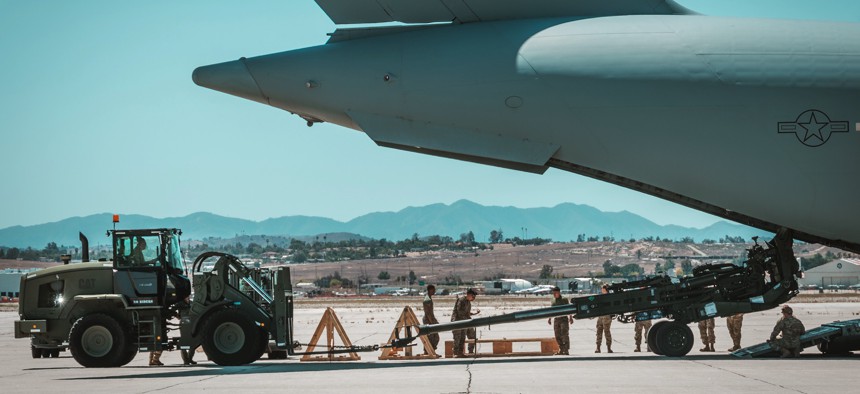
A U.S. Marine Corps M777 towed 155 mm howitzer is loaded into the back of a U.S. Air Force C-17 Globemaster III aircraft at March Air Reserve Base, California, April 23, 2022. U.S. Marine Corps / Staff Sgt. Royce H. Dorman
As Marines’ Arms and Gear Flow to Ukraine, Corps Keeps Close Tabs on Its Own Stocks, Commandant Says
Service leaders have “healthy” discussions with defense secretary during aid-package planning, Berger said.
The Marine Corps is keeping a close eye on the flow of donated weapons and spare parts to Ukraine to make sure their own service doesn’t run low, the service’s top officer said Wednesday.
“The impact there is not just on how many systems we have, but also parts. We have to monitor very closely because it’s like you have another army or another Marine Corps that you’re feeding,” Gen. David Berger, the commandant, told reporters at a Defense Writers Group event. “So at the same time we look at the number of systems and how’s that going to affect us and our war plans and our training, we also have to look at the parts and will that affect our own readiness, our own material readiness.”
Marine howitzers and other weapons are among the billions of dollars’ worth of aid sent to Ukraine in the wake of Russia’s February invasion.
Lt. Col. Garron Garn, a Pentagon spokesperson, said Wednesday they could not detail each service’s donations, citing “operational security considerations.”
Ukraine can request spare parts for their U.S. weapons through American soldiers in Poland.
The Pentagon’s own stockpiles of 155mm artillery shells and some missiles are “dwindling,” CNN reported last month.
Berger said some people have been surprised at Ukraine’s heavy use of unguided artillery rounds in an era of precision weaponry.
“War’s not like that,” he said. “This is a slugfest. This is a human fight.”
The Marines are closely watching their own ammunition stocks to make sure they have enough to maintain readiness and fight a war, Berger said.
“Because [if] you draw that down too much, now the risk is on you,” he said. “Your own readiness might suffer if you didn't monitor it closely. So we have to do that and we have.”
Berger said the service chiefs have “healthy” discussions with Defense Secretary Lloyd Austin about how donating new batches of weapons and gear might affect their services.
“The secretary asks us each time there's a presidential drawdown: ‘Tell me the risk to [operational] plans, tell me the risk to training and readiness’,” he said. “It is no-holds-barred. Nobody's holding back.”
Garn pointed to Austin’s statement that the military would not go below its readiness requirements.
“In selecting specific systems over others, the departments take into consideration what the readiness impacts are of drawing down that equipment from U.S. stocks. We are working to replenish U.S. inventories and backfill depleted stocks of Allies and partners,” the spokesman said in an email.




